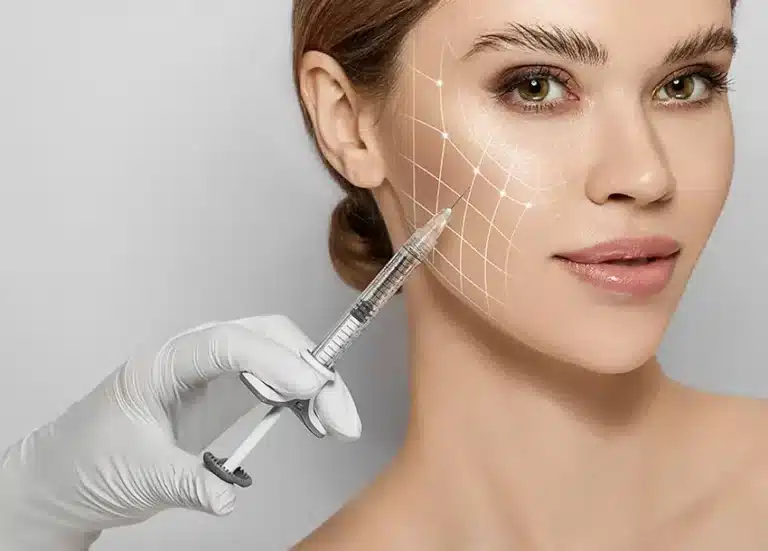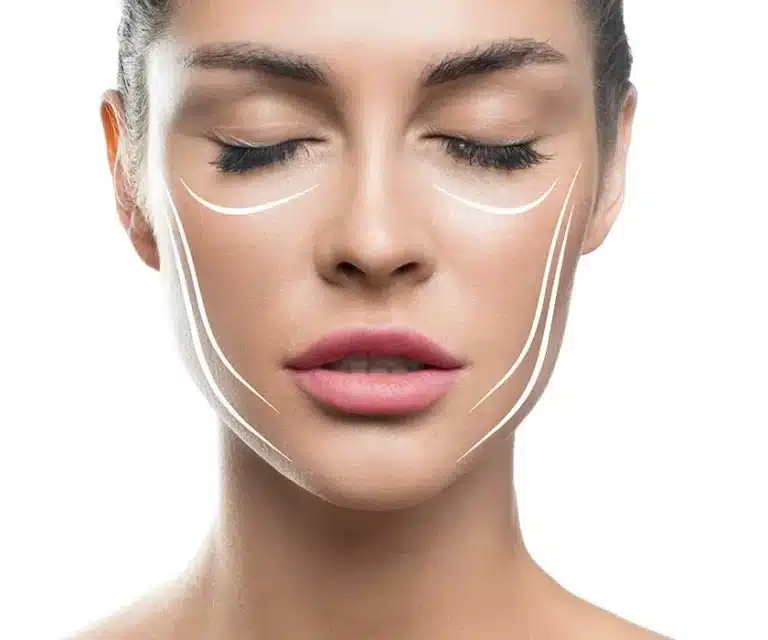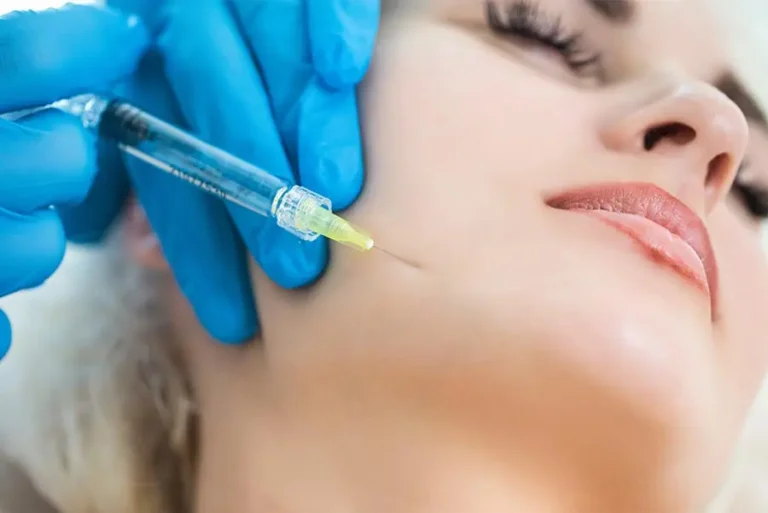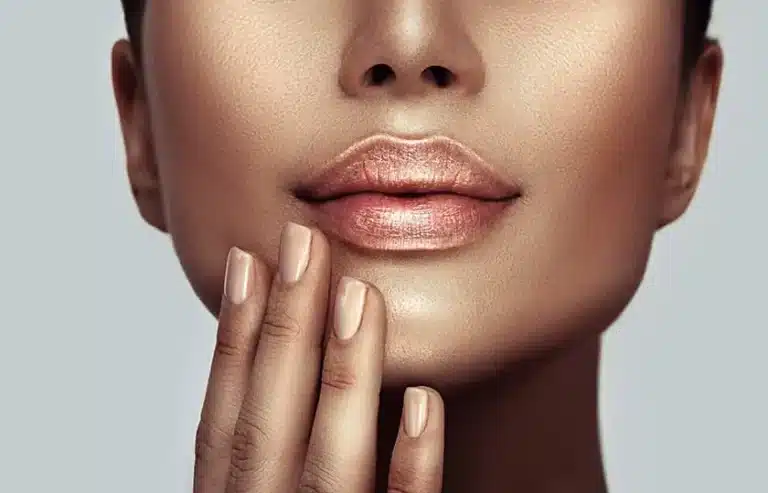Home » Solutions » Injections » Sculptra
Le Sculptra est un produit injectable à base d’acide poly-L-lactique. Ce dernier n’est pas naturellement présent dans le corps, mais il est utilisé en médecine depuis plus de dix ans car il est l’un des composants des fils de suture et d’autres dispositifs médicaux.
Il a été introduit sur le marché pour répondre à la demande de rajeunissement du visage, notamment pour l’atténuation de rides et la restauration naturelle des volumes.
Qu’est-ce que l’acide polylactique ? Le Sculptra est un produit biocompatible et biodégradable largement plébiscité pour son action sur la stimulation de synthèse du collagène.
Ce produit est un des traitements anti-âge employé en médecine esthétique : il est utilisé pour l’amélioration de la qualité de la peau et du relâchement cutané, pour estomper les rides et les ridules et pour traiter et prévenir le vieillissement de la peau. Ce traitement de
rajeunissement du visage offre un effet liftant et repulpant grâce à son action sur la densification de la peau et la restauration des volumes perdus. Il permet ainsi d’atténuer l’aspect fatigué et de corriger le relâchement de l’ovale du visage.
Ce produit est également utilisé pour l’augmentation des fesses et le traitement de la cellulite.
Le docteur Romano réalise les injections de Sculptra à Genève.

Sculptra is a powder (reconstituted with liquid for injection) that stimulates the synthesis of collagen. Results are not immediate but begin to appear around three months after treatment, since three to six months are required for neocollagenesis.
Collagen is an insoluble protein found in the skin and tendons. Its production naturally declines over time. From the age of 18, we lose approximately 1 % of our collagen each year. The reduction in collagen is one of the key causes of aging in the body and face.
Topical creams and oral supplements containing collagen are often insufficient — and frequently ineffective — to compensate for this loss. That is why Sculptra is so valuable.
This treatment is often combined with other aesthetic medicine techniques to address the full range of aging-related concerns.

Initially used in medicine to treat lipoatrophy in HIV patients or congenital volume loss, Sculptra is now considered one of the most discreet techniques for achieving a fresher, more youthful appearance.
Its main advantage is a gradual, natural-looking result with contour restoration that does not add excessive volume. Sculptra provides a subtle tightening effect by densifying the tissues. Skin appears more luminous and toned, with softened fine lines.
Ce traitement peut être proposé à partir de la vingtaine, c’est le moment où la baisse de la production de collagène commence. Dans ce cas, un flacon tous les deux ans est conseillé pour stimuler la synthèse des constituants de la peau.
After the age of 30, Sculptra is often incorporated into a more comprehensive anti-aging protocol that includes other treatments to address multiple signs of aging.
Sculptra est devenu une référence pour les patients qui souhaitent restaurer, de manière naturelle et progressive, les volumes du visage perdus avec le temps, suite à des pathologies ou à des pertes de poids.
L’acide polylactique ne comble pas instantanément les zones creuses, mais il agit en stimulant la production de collagène. Ce processus permet de restaurer la volumétrie faciale de manière harmonieuse.
Sculptra has many benefits for the face.
Sculptra injections are also used preventively to combat early signs of aging.
Sculptra BBL, or Brazilian Butt Lift, is a non-surgical technique used to improve the shape and volume of the buttocks. Unlike the traditional BBL method (liposuction followed by fat injection), Sculptra BBL is performed through the injection of poly-L-lactic acid, which stimulates collagen production in the buttocks. This treatment provides a slight lifting effect to the buttocks, a progressive and natural increase in buttock volume, and an improvement in cellulite.
Although Sculptra was not designed to fill wrinkles, it does improve them.
Notably in the following areas :
These results are achieved through the lifting effect generated by poly-L-lactic acid and by skin densification.
Sculptra is mainly injected into areas of the face where there is the greatest loss of volume and sagging skin.
Les sites d’injection incluent les cheeks, temples, nasolabial folds (lignes qui s’étendent du nez aux coins de la bouche), les marionette lines (the lines that run from the corners of the mouth to the chin).
En fait, ces zones nécessitent de la stimulation de la synthèse de collagène induite par Sculptra ce qui permet de restaurer les volumes perdus, de redéfinir les contours du visage et l’ovale (jowls), d’améliorer la fermeté de la peau.
Pour les injections au niveau du chin and jawline, l’injection de Sculptra n’ est pas systématique. Le docteur Romano en évaluera l’intérêt après une analyse de l’anatomie du patient, cela afin d’éviter d’alourdir le visage et aggraver la ptôse.
Il est crucial que ce traitement soit réalisé par un médecin expérimenté pour garantir une distribution uniforme et naturelle du produit, ainsi que des résultats optimaux et durables.

Lors de la première consultation, le docteur Romano analyse le degré de relâchement cutané et de perte graisseuse.
Le jour de l’injection le Sculptra (qui est vendu sous forme de poudre) est reconstitué avec un anesthésiant et de l’eau pour préparation injectable adaptée à ce type d’injection.
The injection is preceded by pencil marking and rigorous disinfection.
This is carried out using a cannula, a kind of long needle with a round tip. The use of a cannula is preferable as it reduces the number of haematomas and injections required (four to six for a full face) and makes the treatment safer.
L’injection proprement dite dure environ cinq minutes pour un médecin expérimenté, la reconstitution d’un flacon de Sculptra nécessite une dizaine de minutes.
À la fin de la séance, le patient reçoit un carnet avec les étiquettes de traçabilité du produit et peut reprendre ses activités.
Le docteur Romano lui recommande d’éviter de s’exposer à des chaleurs intenses pendant une semaine et de masser la zone suivant la règle connue sous le nom de ‘règle du cinq’ : se masser cinq fois par jour, pendant cinq minutes, pendant cinq jours.
La préparation du produit est une étape délicate qui demande du temps et de la précision. L’acide polylactique se présente sous forme de poudre et doit être dilué avec de l’eau pour préparations injectables, à laquelle on ajoute de la xylocaïne afin d’améliorer le confort du patient lors de l’injection.
Une fois reconstitué, plusieurs pratiques coexistent : certains préfèrent laisser le produit au réfrigérateur toute une nuit (préparation la veille), d’autres le laissent reposer environ deux heures, tandis que certains professionnels l’utilisent immédiatement.
Le massage après l’injection est une étape essentielle pour optimiser les résultats du traitement. Il permet une répartition homogène du produit, réduit le risque de formation de nodules et favorise une stimulation optimale de la production de collagène. Après chaque séance, il est donc recommandé de masser délicatement les zones traitées.
What is the 5 5 5 rule for Sculptra ? Après l’injection, le patient doit masser les zones traitées cinq fois par jour, pendant cinq minutes, durant cinq jours.
Cette consigne post-traitement est indispensable pour maximiser les effets de Sculptra : elle contribue à obtenir une peau plus lisse, plus ferme, et un volume facial restauré de manière harmonieuse et naturelle.

Un flacon de Sculptra est généralement suffisant pour traiter l’ensemble du visage. Le nombre de séances nécessaires est déterminé lors de la consultation. En règle générale, avant trente ans, une seule séance suffit. Après quarante ans, il est recommandé d’utiliser un flacon par décennie de vie. Ainsi, une femme de cinquante ans aura besoin de cinq flacons. En pratique, le docteur Romano réalise souvent moins de séances, car de nombreux patients ont déjà bénéficié d’autres traitements (laser, acide hyaluronique…) et le Sculptra s’intègre dans un protocole combiné. Pour le corps, trois à quatre séances sont généralement nécessaires, avec un nombre plus important de flacons. Dans le cadre du traitement de la cellulite des fesses, par exemple, trois à quatre flacons par séance sont requis. Les séances sont à renouveler tous les deux ans.
The number of required treatments depends on various factors, including the area to be treated.
For the face, it is important not to exceed one vial per session to avoid the risk of nodule formation.
Multiple sessions may be necessary to achieve the desired correction.
The number of sessions is determined before starting treatment.
For the face, one vial is used per session. For the buttocks, 4 to 6 vials per session are used. It is important not to exceed these dosages to avoid the risk of nodules appearing.
For the face, one vial per decade of life is often used. A patient who is 40 years old will need 4 vials, a 50-year-old patient will need 5 vials. The number of vials depends on each patient’s anatomy and is determined during a consultation. Often, patients have already had hyaluronic acid injections, which reduces the number of poly-L-lactic acid vials needed.

Sculptra delivers remarkable results in terms of facial rejuvenation.
The effects are progressive and increase as the biostimulation process intensifies. Sculptra is the treatment of choice for patients seeking natural and long-lasting rejuvenation.
The session is nearly painless, and after-effects are simple, with no social downtime required.
Hematomas are possible as with any injection, but they are harmless.
The treated area remains slightly swollen and pink for a few hours.
Before any medical procedure, the physician checks for conditions that prohibit the treatment.
Sculptra and fillers (dermal fillers) are two distinct approaches to facial rejuvenation and volume restoration.
Sculptra, à base d’acide poly-L-lactique, se caractérise par sa capacité à stimuler progressivement la production de collagène, améliorant ainsi la qualité et la fermeté de la peau de manière durable. Les résultats apparaissent progressivement, l’effet est naturel et subtil.
L’acide hyaluronique donne des résultats immédiats en comblant les rides et les creux et en ajoutant du volume à des éléments du visage tels que les lèvres, les pommettes, le menton. Les fillers sont idéaux pour les patients qui souhaitent une correction rapide et visible des signes de vieillissement.
The choice between Sculptra and fillers depends on individual aesthetic needs and the desired results.
Sculptra et Radiesse sont des traitements de comblement dermique utilisés pour le rajeunissement du visage. Ils ont des indications différentes.
Sculptra est composé d’acide poly-L-lactique et a été conçu pour stimuler progressivement la production de collagène par l’organisme, offrant des résultats durables et naturels sur une période prolongée. Ce traitement est idéal pour les patients qui veulent améliorer la qualité et la fermeté de la peau de manière progressive et discrète.
Radiesse est composé de microsphères d’hydroxyapatite de calcium, il donne un effet volumateur immédiat et durable. Il est particulièrement efficace pour les zones nécessitant un soutien structurel et une augmentation instantanée du volume, comme les joues et les rides du sourire.
Bien que les deux traitements puissent être complémentaires, le choix entre Sculptra et Radiesse dépend des objectifs esthétiques du patient et des résultats souhaités.
En matière de rajeunissement, le Sculptra et l’Ultherapy sont deux traitements innovants offrant des approches distinctes pour le relâchement du visage.
Le Sculptra procure une amélioration progressive des contours du visage et de la fermeté de la peau, en stimulant progressivement la production de collagène.
L’Ultherapy utilise la technologie des ultrasons focalisés pour ‘chauffer’ les couches cutanées profondes, stimuler la production de collagène et la rétractation des tissus profonds. Ce traitement non invasif est particulièrement efficace pour lifter et tonifier les zones du visage. Le docteur Romano considère que les résultats de ce traitement sont très variables et ne le conseille pas.
Sculptra focuses on restoring volume and skin structure through “internal regeneration”, while Ultherapy promotes a lifting effect and skin tissue tightening.
Sculptra et la botulinic toxin sont deux traitements esthétiques populaires, mais ils agissent de manière différente.
Sculptra est un stimulateur de la synthèse de collagène qui agit progressivement, les résultats durent deux ans. Sculptra traite le relâchement cutané et les pertes de volume.
La toxine botulique est un neurotoxine qui agit en relaxant temporairement les muscles responsables de certaines rides : rides du front, rides du lion, rides de la patte d’oie.
En médecine esthétique, différents traitements peuvent donner des résultats proches, mais ils ne sont pas pour autant identiques, car chaque technique possède ses propres caractéristiques. Ainsi, il n’existe pas réellement d’alternative équivalente au Sculptra. Selon le docteur Romano, seule cette technique permet de densifier efficacement le tissu sous-cutané — cette couche de graisse physiologique située juste sous la peau — qui s’amincit avec le temps. Théoriquement, les alternatives sont :
The cost of a Sculptra session in Geneva is 900 CHF per vial.
The number of vials required varies depending on the patient’s age, tissue quality, and the areas treated (facial contour, temples, cheeks, cheekbones, etc.). In general, two to three sessions spaced several weeks apart are recommended for a progressive and natural result. Only one vial for the face is injected at each session.
The treatment price is therefore set per vial, with full transparency, and without any imposed package. The preliminary medical consultation allows for an accurate assessment of the needs and the development of a personalized treatment plan.
Although the initial cost may seem high, the result is long-lasting. Improvements are progressive and natural, lasting up to two years or more.
Les patients sont satisfaits des résultats de Sculptra. Ils apprécient particulièrement le côté naturel et progressif des améliorations. Ils décrivent une peau visiblement plus ferme et plus lisse, dont la qualité est globalement améliorée, avec une réduction notable des rides. Ils louent également la restauration subtile des volumes du visage, notamment au niveau des joues et des tempes, ce qui donne un air reposé.
La stimulation de la synthèse de collagène induite par Sculptra est très appréciée, les résultats sont durables et continuent à s’améliorer avec le temps.
Les patients apprécient l’efficacité de ce traitement pour l’amélioration de la qualité et de la densité de la peau. Ils remarquent une réduction de la profondeur et de la visibilité des cicatrices, grâce à la stimulation progressive de la production de collagène par l’acide poly-L-lactique contenu dans Sculptra.
Cette régénération naturelle aide à lisser et à combler les cicatrices déprimées, la surface cutanée devient ainsi plus uniforme et plus lisse.
Néanmoins, si une fibrose importante est associée aux cicatrices, les résultats ne seront pas spectaculaires.
D’après les patients, le Sculptra est une méthode de choix pour traiter le relâchement cutané et restaurer les volumes du visage.
Les patients décrivent une amélioration de la fermeté de la peau, avec un effet lifting progressif et une redéfinition des contours du visage.
Ils apprécient particulièrement le fait que les résultats apparaissent progressivement, permettant des améliorations subtiles et harmonieuses sans changements brusques.
Le Sculptra est plébiscité pour son efficacité sur le rajeunissement du visage, il est considéré comme une solution complète contre le relâchement cutané et la perte de volume.
Une fiole de Sculptra contient 367,5 mg d’acide poly-L-lactique sous forme de poudre lyophilisée, qui doit être reconstituée avec un diluant avant l’injection. La quantité de diluant utilisée pour reconstituer la poudre peut varier en fonction des préférences du médecin et des besoins spécifiques du patient, mais elle se situe généralement entre 5 mL et 16 mL. Cette flexibilité permet au médecin de personnaliser la concentration et le volume final du produit pour optimiser les résultats du traitement.
Une consultation avec un médecin e expérimenté est le meilleur moyen de déterminer si Sculptra est adapté à vos besoins spécifiques. Le médecin évaluera votre peau, discutera de vos objectifs esthétiques et élaborera un plan de traitement personnalisé pour vous aider à atteindre les résultats souhaités.
Sculptra stands out for its ability to stimulate collagen production, delivering long-lasting, natural results that can last up to two years. Unlike dermal fillers, which give immediate but temporary results, Sculptra improves the structure and firmness of the skin in a gradual but much more lasting way.
Sculptra est un traitement efficace pour de nombreux patients qui souhaitent améliorer la fermeté et la densité cutanée et le volume du visage, mais il n’est pas nécessairement adapté à tous. Il est indiqué pour les personnes qui souhaitent le traitement progressif et naturel des signes de vieillissement. Le Sculptra n’est pas le traitement idéal pour les personnes désireuses d’un résultat immédiat.
Les résultats de Sculptra sont durables, avec des améliorations visibles qui peuvent persister jusqu’à deux ans, en fonction des caractéristiques individuelles de chaque patient et de leur métabolisme. La stimulation continue de la synthèse collagène offre une amélioration progressive et durable de la fermeté et de la qualité de la peau.
The results of a 25-month clinical trial lasted over 2 years.
The number of treatments required depends on the patient's needs and the degree of correction required. In general, one to three sessions are carried out, spaced two months apart. Results appear gradually. Improvements are visible after each session.
Oui, Sculptra est un traitement sûr lorsqu’il est injecté par un médecin qualifié et expérimenté. L’acide poly-L-lactique, le composant principal de Sculptra, est utilisé en médecine depuis des décennies, il est biocompatible et biodégradable, ce qui le rend bien toléré par l’organisme.
Although the results are not immediate, Sculptra starts to work (by stimulating collagen synthesis) as soon as the injection is given.
Results start to become visible three weeks after the last session and are optimal three months later.
Yes, you can resume your usual activities immediately after treatment. However, it is advisable to avoid sport and exposure to intense heat for two days.
The treatment is slightly uncomfortable but fairly quick. Patients tolerate it well but find it more painful than conventional injections.
Results are progressive but the treatment is effective and the benefits long-lasting.
There is no solid scientific evidence that Sculptra causes autoimmune diseases. This product has been used safely for years.
The product does not move, so patients can assume any position they wish during sleep.
Un léger gonflement peut survenir après le traitement, mais il est temporaire et disparaît généralement en une heure. Le Sculptra, si injecté par un médecin expérimenté, ne gonfle pas le visage. Il est donc crucial de consulter un médecin formé à la technique.
Before Sculptra, it is best to avoid alcohol, anti-inflammatory drugs and certain food supplements, as they may increase the risk of bleeding or bruising.
Les injections de Sculptra, de toxine botulique et d’acide hyaluronique sont couramment utilisées pour rajeunir le visage.
The satisfaction rate for treatment with Sculptra is high, close to 100%. However, it must be the right indication and the product must be injected correctly.
Yes, Sculptra stimulates collagen production, which helps restore volume to the face and reduce the signs of ageing.
Pour obtenir les meilleurs résultats il faut simplement suivre les consignes données après la procédure : masser selon la règle 5 5 5, éviter les activités physiques intenses et les fortes chaleurs pendant deux jours.
Not massaging the treated area can lead to uneven distribution of the product, which may compromise the final result or cause nodules to form.
It is possible to wash the face a few hours after the treatment, but for two days it is recommended to use only water (no soaps or exfoliants) and to avoid rubbing the treated area vigorously.
It is difficult to know exactly which celebrities have used Sculptra, as this is a matter for their private lives. However, many celebrities opt for this type of treatment to maintain their natural appearance and baby-smooth skin.